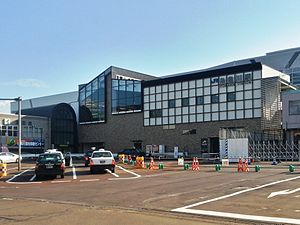Itoigawa Station 糸魚川駅 | ||||||||||||||||||||||||||
|---|---|---|---|---|---|---|---|---|---|---|---|---|---|---|---|---|---|---|---|---|---|---|---|---|---|---|
 Itoigawa Station in December 2013 | ||||||||||||||||||||||||||
| Japanese name | ||||||||||||||||||||||||||
| Shinjitai | 糸魚川駅 | |||||||||||||||||||||||||
| Kyūjitai | 絲魚川驛 | |||||||||||||||||||||||||
| Hiragana | いといがわえき | |||||||||||||||||||||||||
| General information | ||||||||||||||||||||||||||
| Location | 1-7-10 Ōmachi,
Itoigawa City,
Niigata Prefecture 941-0061 Japan | |||||||||||||||||||||||||
| Coordinates | 37°2′38″N 137°51′45″E / 37.04389°N 137.86250°E | |||||||||||||||||||||||||
| Operated by | ||||||||||||||||||||||||||
| Line(s) | ||||||||||||||||||||||||||
| Platforms | 1
island + 1
side platforms (Oito Line, Hisui Line) 2 side platforms (Shinkansen) | |||||||||||||||||||||||||
| Other information | ||||||||||||||||||||||||||
| Status | Staffed ( Midori no Madoguchi) | |||||||||||||||||||||||||
| History | ||||||||||||||||||||||||||
| Opened | 16 December 1912 | |||||||||||||||||||||||||
| Passengers | ||||||||||||||||||||||||||
| FY2016 | 1,205 daily | |||||||||||||||||||||||||
| Services | ||||||||||||||||||||||||||
| ||||||||||||||||||||||||||
| Location | ||||||||||||||||||||||||||
Itoigawa Station (糸魚川駅, Itoigawa-eki) is a railway station in Itoigawa, Niigata, Japan, operated by West Japan Railway Company (JR West) and the third-sector railway operator Echigo Tokimeki Railway. It is also a freight terminal for the Japan Freight Railway Company.
Lines
Itoigawa Station is served by the JR West high-speed Hokuriku Shinkansen and the local Ōito Line, and is located 213.9 kilometers from Takasaki Station and 318.9 kilometers from Tokyo Station. It is 105.4 kilometers from Matsumoto Station, the terminus of the Ōito Line. For the Echigo Tokimeki Railway Nihonkai Hisui Line, the station is 29.9 kilometers from Tomari Station and 315.0 kilometers from Maibara Station.
Station layout

The local portion of the station has one side platform and one island platform with a cut-out, serving four tracks in total. The Shinkansen portion of the station has two opposed side platforms, located above the local train platforms. The station building is located below the tracks and platforms. The station has a Midori no Madoguchi staffed ticket office.
Platforms
| 1 | ■ Nihonkai Hisui Line | for Naoetsu |
| 2 | ■ Nihonkai Hisui Line | for Naoetsu for Ichiburi |
| 3 | ■ Nihonkai Hisui Line | for Ichiburi |
| 4 | ■ Ōito Line | for Minami-Otari |
| 11 | ■ Hokuriku Shinkansen | for Nagano and Tokyo |
| 12 | ■ Hokuriku Shinkansen | for Toyama and Kanazawa |
The departure melody used for the Shinkansen platforms is the traditional children's song "Haru yo Koi" (春よ来い), the lyrics for which were written by Gyofū Sōma, a native of Itoigawa. [1]
History

The station opened on 16 December 1912. [2] With the privatization of JNR on 1 April 1987, the station came under the control of JR West. [2]
The platforms for the Hokuriku Shinkansen opened for service on 14 March 2015. [3]
From 14 March 2015, with the opening of the Hokuriku Shinkansen extension from Nagano to Kanazawa, local passenger operations over sections of the Shinetsu Main Line and Hokuriku Main Line running roughly parallel to the new shinkansen line were reassigned to third-sector railway operating companies. [4] From this date, operations of former Hokuriku Main Line services were transferred to the ownership of the third-sector operating company Echigo Tokimeki Railway.
Passenger statistics
In fiscal 2016, the station was used by an average of 1205 passengers daily (boarding passengers only). [5]
Surrounding area
- Itoigawa City Hall
 National Route 8
National Route 8
See also
References
- ^ 北陸新幹線 発車メロディの決定について [Departure melodies chosen for Hokuriku Shinkansen]. News release (in Japanese). Japan: West Japan Railway Company. 9 December 2014. Archived from the original on 10 December 2014. Retrieved 10 December 2014.
- ^ a b Ishino, Tetsu, ed. (1998). 停車場変遷大辞典 国鉄・JR編 [Station Transition Directory - JNR/JR]. Vol. II. Japan: JTB. p. 142. ISBN 4-533-02980-9.
- ^ "データで見るJR西日本 2022" [JR West Japan 2022 in Data] (PDF). westjr.co.jp (in Japanese). 2022. pp. 88–90. Archived from the original (PDF) on 14 December 2022. Retrieved 7 February 2023.
- ^ Osano, Kagetoshi (March 2015). 北陸新幹線並行在来線各社の姿 [Guide to companies operating conventional lines alongside the Hokuriku Shinkansen]. Tetsudō Daiya Jōhō Magazine (in Japanese). 44 (371). Japan: Kōtsū Shimbun: 28–33.
- ^ 統計いといがわ 第10章 運輸・通信 (PDF) [Itoigawa official statistics No.10 Transportation and Communications] (PDF) (in Japanese). Japan: Itoigawa City Government. 2016. Archived from the original (PDF) on 17 November 2017. Retrieved 12 September 2018.
External links
- Itoigawa Station (JR West official page) (in Japanese)
- Echigo Tokimeki Railway HP Archived 16 March 2015 at the Wayback Machine (in Japanese)



